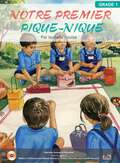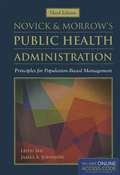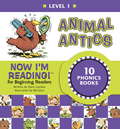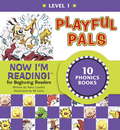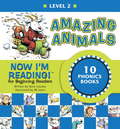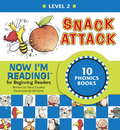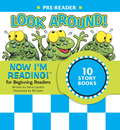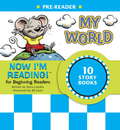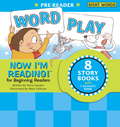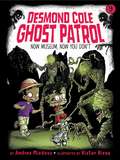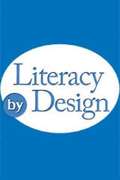- Table View
- List View
Notre Premier Pique-Nique class 1 - MIE
by Par Isabelle Louise"Notre Premier Pique-Nique" présente une histoire captivante centrée autour d'une expérience de pique-nique pour les jeunes élèves. Lors de cette aventure, les enfants se dirigent vers un parc voisin de leur école, accompagnés de leur enseignante, Miss Dina. Installés pour le goûter, ils partagent leurs provisions et découvrent ce que chacun a apporté. Miss Dina montre ses achats, soulignant ainsi l'aspect convivial du moment. Après le goûter, les enfants sont laissés libres pour jouer. Cependant, le temps passe vite et le retour en classe est annoncé avec l'arrivée du van. Ce livre engage les élèves dans une exploration interactive du vocabulaire et des activités associées aux pique-niques, tout en incitant à partager leurs expériences personnelles. Il vise à développer leur compréhension du récit tout en suscitant leur intérêt pour les moments de partage en plein air.
Novick & Morrow's Public Health Administration: Principles for Population-Based Management (Third Edition)
by James Johnson Leiyu ShiWith contributions from experts in areas ranging from workforce to community-based prevention to emergency preparedness, this thoroughly revised edition offers detailed, comprehensive coverage of current, relevant issues for new as well as seasoned public health administrators.
Now I'm Reading! Level 1: Animal Antics
by Nora Gaydos B. B. SamsTEACH YOUR CHILD TO READ WHILE HAVING FUN! Simple, patterned stories and strong picture cues help children build essential skills in Level 1 of this award-winning learn-to-read series.The Now I'm Reading! books offer a comprehensive approach that integrates the best of phonics and storytelling to help young readers take the first steps toward independent reading success.In LEVEL 1: ANIMAL ANTICS, children learn essential phonics skills while reading humorous stories featuring fun animal heros. Stories 1-5 focus on mostly three-letter short-vowel words, some consonant blends, and early sight words. Stories 6-10 progress to mostly four-letter short-vowel words, plus additional sight words and consonant blends. All stories feature hilarious pictures and stories that will have children excited to read them again and again!Inside this eBook, you'll find:· 10 stories with colorful illustrations and engaging text· "After You Read" extended activity sections· A Parent/Teacher Guide to help you figure out the best ways to use these booksPerfect for ages 4 and up! Level 1 NIR readers focus on short-vowel sounds, simple consonant sounds, and beginning sight word introduction.The concepts and skill progression in the NIR series are aligned to meet Common Core State Standards. This book is Fountas & Pinnell Leveled with a range of C-F; information on individual booklet levels and Lexile Measures is available at the Now I'm Reading website.
Now I'm Reading! Level 1: Playful Pals
by Nora Gaydos B. B. SamsTEACH YOUR CHILD TO READ WHILE HAVING FUN! Simple, patterned stories and strong picture cues help children build essential skills in Level 1 of this award-winning learn-to-read series.The Now I'm Reading! books offer a comprehensive approach that integrates the best of phonics and storytelling to help little ones take the first steps toward independent reading success.In LEVEL 1: PLAYFUL PALS, children learn essential phonics skills while reading humorous stories featuring fun animal heroes. The stories focus on short-vowel words, consonant blends, and early sight words. Each story uses three- and four-letter words to keep the text age-appropriate, and is "just right" for building self-confidence along with skill!Inside this eBook, you'll find:· 10 stories with colorful illustrations and engaging text· "After You Read" extended activity sections· A Parent/Teacher Guide to help you figure out the best ways to use these booksPerfect for ages 4 and up! Level 1 NIR readers focus on short-vowel sounds,simple consonant sounds, and beginning sight words.The concepts and skill progression in the NIR series are aligned to meet Common Core State Standards. This book is Fountas & Pinnell Leveled with a range of D-F; information on individual booklet levels and Lexile Measures is available at the Now I'm Reading website.
Now I'm Reading! Level 2: Amazing Animals
by Nora Gaydos B. B. SamsLEARN TO READ WHILE HAVING FUN! Level 2 of this award-winning learn-to-read series continues to help children develop the skills they need for independent reading success.The Now I'm Reading! books offer a comprehensive approach that integrates the best of phonics and storytelling to help young readers take their first steps toward reading success.In LEVEL 2: AMAZING ANIMALS, children learn essential phonics skills while reading humorous stories featuring fun animal heroes--like an ape baking a cake for his date, a goat in a boat that won't float, and more! Using an effective step-by-step approach that pairs patterned text with strong picture cues, the stories in this collection introduce children to long-vowel sounds, consonant blends, word endings, and key sight words.Inside this eBook, you'll find:· 10 stories with colorful illustrations and engaging text· "After You Read" extended activity sections· A Parent/Teacher Guide to help you figure out the best ways to use these booksPerfect for ages 4 and up! Level 2 NIR readers focus on long- and short-vowel sounds, expanded simple consonant sounds, and beginning sight word reinforcement.The concepts and skill progression in the NIR series are aligned to meet Common Core State Standards. This book is Fountas & Pinnell Leveled with a range of E-G; information on individual booklet levels and Lexile Measures is available at the Now I'm Reading website.
Now I'm Reading! Level 2: Snack Attack
by Nora Gaydos B. B. SamsLEARN TO READ WHILE HAVING FUN! Level 2 of this award-winning learn-to-read series continues to help children develop the skills they need for independent reading success.The Now I'm Reading! books offer a comprehensive approach that integrates the best of phonics and storytelling to help young readers take their first steps toward reading success.Yum, snacks! In LEVEL 2: SNACK ATTACK, children learn essential phonics skills while reading humorous stories featuring fun animal heroes. Using an effective step-by-step approach that pairs patterned text with strong picture cues, the stories in this collection introduce children to long-vowel sounds, consonant blends, sight words, and word endings.Inside this eBook, you'll find:· 10 stories with colorful illustrations and engaging text· "After You Read" extended activity sections· A Parent/Teacher Guide to help you figure out the best ways to use these booksPerfect for ages 4 and up! Level 2 NIR readers focus on long- and short-vowelsounds, expanded simple consonant sounds, and beginning sight word reinforcement. The concepts and skill progression in the NIR! series are aligned to meet Common Core State Standards. This book is Fountas & Pinnell Leveled with a range of D-H; information on individual booklet levels and Lexile Measures is available at the Now I'm Reading website.
Now I'm Reading! Pre-Reader: Look Around!
by Nora Gaydos B. B. SamsTEACH YOUR CHILD TO READ WHILE HAVING FUN! Simple sentences and strong picture cues help guide young children to reading success with this award-winning learn-to-read series.What could be more exciting than hearing your child read a book to you for the first time? The Now I'm Reading! books for emerging readers are just right for children who want to read but aren't quite ready to sound out words using phonics. At the Pre-Reader level, each of the 10 stories in LOOK AROUND! uses a proven system of simple, patterned text and strong visual cues to build confidence in the earliest readers. Each story focuses on a specific early-learning concept (like colors, animals, family, and shapes) to help kids feel like "real" readers as they learn simple sight words and reading habits.Inside this eBook, you'll find:· 10 stories with colorful illustrations and engaging text· "Words to Know" and "Stretch Your Mind" activity sections· A Parent/Teacher Guide to help you figure out the best ways to use these booksPerfect for ages 3 and up! Books in the NIR Pre-Reader Level focus on read-along stories, strong picture clues, predictable patterned text, and letter and sound recognition.The concepts and skill progression in the NIR! series are aligned to meet Common Core State Standards. This book is Fountas & Pinnell Level A/B; information on individual booklet levels and Lexile Measures is available at the Now I'm Reading website.
Now I'm Reading! Pre-Reader: My World
by Nora Gaydos B. B. SamsTEACH YOUR CHILD TO READ WHILE HAVING FUN! Simple sentences and strong picture cues help guide young children to reading success with this award-winning learn-to-read series.What could be more exciting than hearing your child read a book to you for the first time? The Now I'm Reading! books for emerging readers are just right for children who want to read but aren't quite ready to sound out words using phonics. Each of the 10 stories in PRE-READER: MY WORLD uses a proven system of simple, patterned text and strong picture cues to build confidence in the earliest readers. Each booklet focuses on a specific early-learning concept (like opposites, farm animals, and movement) to help kids feel like "real" readers as they learn simple sight words.Inside this eBook, you'll find:· 10 story booklets with colorful illustrations and engaging text· 40 reward stickers to encourage completion and rereading· "Words to Know" and "Stretch Your Mind" activity sections· Parent/Teacher Guide to help you figure out the best ways to use these booksPerfect for ages 3 and up! Books in the NIR Pre-Reader Level focus on read-along stories, strong picture clues, predictable patterned text, and letter and sound recognition.The concepts and skill progression in the NIR! series are aligned to meet Common Core State Standards. This book is Fountas & Pinnell Level A-E; information on individual booklet levels and Lexile Measures is available at the Now I'm Reading website.
Now I'm Reading! Pre-Reader: Word Play
by Mary Sullivan Nora GaydosTEACH YOUR CHILD TO READ WHILE HAVING FUN! Simple sentences and strong picture cues help guide young children to reading success with this award-winning learn-to-read series.What could be more exciting than hearing your child read a book to you for the first time? The Now I'm Reading! books for emerging readers are just right for children who want to read but aren't quite ready to sound out words using phonics.Each of the 8 stories in PRE-READER: WORD PLAY uses a proven system of simple, patterned text and strong picture cues to build confidence in the earliest readers. Each booklet focuses on at least 2 specific high-frequency sight words, which are introduced in an appropriate and organized sequence.Inside the CD binder-like package, you'll find:· 8 stories with engaging text and fun illustrations· "Words to Know" and "Stretch Your Mind" activity sections· Parent/Teacher Guide to help get the most out of each story· Activity Book with suggestions for ways to expand your pre-reader's skillsPerfect for ages 3 and up! Books in the NIR Pre-Reader Level focus on read-along stories, strong picture clues, predictable patterned text, and letter and sound recognition.The concepts and skill progression in the NIR! series are aligned to meet Common Core State Standards. This book is Fountas & Pinnell Level LB-A; information on individual booklet levels and Lexile Measures is available at the Now I'm Reading website.
Now Museum, Now You Don't: Now Museum, Now You Don't; Ghouls Just Want To Have Fun; Escape From The Roller Ghoster; Beware The Werewolf (Desmond Cole Ghost Patrol #9)
by Andres MiedosoDesmond Cole goes on a field trip to the museum in the ninth book of the Desmond Cole Ghost Patrol series!Museums are great places to see really old stuff. The Kersville Museum has old paintings, old statues, and even old mummies that come with old curses. Sounds like a perfectly safe place to visit for family fun. Until the mummies start to disappear! With easy-to-read language and illustrations on almost every page, the Desmond Cole Ghost Patrol chapter books are perfect for emerging readers.
Now You See Me (Fountas & Pinnell Classroom, Guided Reading Grade 4)
by Santy Gutierrez Heller LandeckerNIMAC-sourced textbook
Nuestra Tierra cambia: Una enciclopedia de accidentes geográficos (¡Arriba la Lectura!, Level N #87)
by Darleen RamosNuestra Tierra siempre está cambiando. Los terremotos, el viento, el agua y el hielo cambian la forma del planeta. ¿Sabes cuál es el cañón más grande del mundo? NIMAC-sourced textbook
Nuestra bandera (¡Arriba la Lectura!, Level D #13)
by Cindy Harris Ken O’DonoghueNIMAC-sourced textbook. ¿Sabes cómo es nuestra bandera? En este libro podrás aprender muchos detalles.
Nuestra ciudad (¡Arriba la Lectura!, Level I #69)
by Kim UlanderNIMAC-sourced textbook. Hay muchos lugares para visitar en nuestra ciudad. Veamos adónde vamos y qué hacemos en cada lugar.
Nuestras Comunidades
by James A. Banks Kevin P. Colleary Walter C. Parker Gloria Contreras Mary A. Mcfarland A. Lin Goodwin Richard BoehmA Social Studies, literature and culture.
Nuestras supergallinas (¡Arriba la Lectura!, Level N #33)
by James Hart Marg McAlisterNIMAC-sourced textbook
Nuestro Estado (Grade 4, Edicion para Texas)
by James A. Banks Kevin P. Colleary Walter C. Parker Gloria Contreras Mary A. Mcfarland A. Lin Goodwin Richard BoehmA Spanish History, Culture, Science, Geography, Economy, Civics, Government, Society and Technology textbook.
Nuestro huerto (¡Arriba la Lectura!, Level E #28)
by Sally Cowan Lyz Turner-ClarkNIMAC-sourced textbook. Aprende a preparar y cuidar un huerto. ¡Después podrás comer ricos vegetales!

